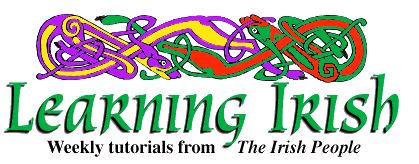
Irish Lesson 16
|
PRONUNCIATION The letter "f" in Irish is pronounced almost like the "f" in English, except that you must start with the inside of the lower lip against the edge of the upper front teeth. Then, if "a", "o" or "u" is the nearest vowel to the "f", move both lips out for the vowel sound. Examples: fá (faw*), fód (fohd), fuar (FOO-uhr), scríofa (SHKREE-fuh). This is the broad sound of "f". Start the slender sound the same way, but draw the lower lip back a little to make the vowel sound. Try: fear (far), féin (fay*n), fill (fil), deifir (DE-fir), fliuch (flyuhk*). In some cases "f" is pronounced (h). We will study this later. VOCABULARY Masculine nouns solas (SUH-luhs), light balla (BAHL-luh), wall sorn (SOHR-ruhn), stove cúisneoir (koosh-NYOH-ir), refrigerator gloine (GLIN-e), glass doirteal (DUHRT-uhl), sink forc (fohrk), fork fó-chupán (FOH-k*u-PAW*N), saucer citeal (KIT-uhl), kettle naipcín (nap-KEEN), napkin pota (POHT-uh), pot sconna (SKOHN-uh), faucet éadach boird, an t-eadach boird (AY*-duhk*BWIRD, un TAY*-duhk*BWIRD), tablecloth, the tablecloth oigheann, an t-oigheann (EYE-uhn, un TEYE-uhn), oven, the oven Feminine nouns scian, an scian (SHKEE-uhn), knife síleáil, an tsíleáil (SHEEL-aw*-il, un TEEL-aw*-il), ceiling cathaoir, an chathaoir (KAH-heer, un K*AH-heer), chair Phrases i lár na sráide (i LAW*R nuh SRAW*-de), in the middle of the street ag ól bainne (eg OHL BAHN-ye), drinking milk ag ól tae (eg OHL tay*), drinking tea ag ól uisce (eg OHL ISH-ke), drinking water ag ithe a bhricfeasta (eg I-he uh vrik-FAS-tuh), eating breakfast Go hiontach (goh HOON-tuhk*), Great! DRILLS We will try a vocabulary drill first, to help you learn the larger vocabulary that you are acquiring. Go to the kitchen and begin this drill for each object you can name: Céard é seo? (kay*rd ay* shuh), What is this? Or ( Céard é sin? (shin), What is that? Is ___ é. Tá an ___ anseo (un-SHUH), The ___ is here. Continue for as many objects as you can name. If necessary, replace "anseo" by one of these: ansin (un-SHIN), there; ar an mbord (er un mohrd), on the table; ar an urlár (er un oor-LAW*R), on the floor; ar an mballa (er un MAHL-luh), on the wall. The next drill is a mini-conversation drill. Do these short exercises alone or with another student. Repeat them several times to get the full benefit from them. 1. Cé atá ag teacht? (kay* taw* uh TYAHK*T), Who is coming? Tá Séamas, an ea? (un A) Séamas is it? Is ea (sha), It is. Nach bhfuil Brian ag teacht freisin? (FRESH-in), also. Ó, níl. Tá sé amuigh sa tsráid (uh-MWEE), He's out in the street. 2. Cé atá imeacht? (eg im-AHK*T), Who is leaving? Tá Ruairí (ROH-i-ree) ag imeacht. Nach bhfuil Seán ag imeacht freisin? Ó, níl. Tá sé sa seomra eile fós (suh SHOHM-ruh EL-e fohs), He's still in the other room. 3. Cé atá ag ithe a bhricfeasta (eg I-he uh vrik-FAS-tuh), eating his breakfast Liam, an ea? Is ea. Nach bhfuil sé ag obair fós? (eg OH-bir), Isn't he at work yet? Níl sé ag obair fós. Tá sé déanach (DAY*N-uhk), He's late. 4. Céard atá tú a dhéanamh? (uh YAY*N-uhv), What are you doing? Tá mé ag déanamh báid (BAW*-id), I'm making a boat. Bád, an ea? (baw*d, un A), A boat, is it? Is ea. Nach maith an buachaill tú! (BOO-uhk*-il), Aren't you the good boy! 5. Cá bhfuil Seoirse ag siúl? (SHOHR-she uh SHOOL), Where is George walking? Tá sé ag siúl ar an gcosán (er un guh-SAW*N), He's walking on the sidewalk. Ar an gcosán, an ea? Is ea. Maith an fear é! (mah un far ay*), He's a good man! 6. An bhfuil tú ag ól bainne? (eg ohl BAHN-ye), Are you drinking milk? Níl mé ag ól bainne, ar chor ar bith (er HUHR er BI), not at all. Céard atá tú ag ól, mar sin? (mahr shin), What are you drinking, then? Tá mé ag ól uisce (ISH-ke), I am drinking water. Uisce fuar, an ea? Is ea. 7. An bhfuil tú ag scríobh litreach? (uh shkreev LI-trahk*), Are you writing a letter? Níl mé ag scríobh litreach anois (uh-NISH). Tá mé tuirseach (taw* may* toor-SHAHK*), I am tired. Tuirseach, an ea? Is ea. 8. Cé atá ag fanacht amuigh? (uh fahn-uhk*t uh-MWEE), Who is waiting outside? Nach bhfuil do mháthair amuigh ar an gcosán? (duh VWAW*-hir), Isn't your mother out on the sidewalk? Má tá sí, abair léi teacht isteacht (maw* taw* shee, AH-bir lay* tyahk*t ish-TYAHK*), If she is, tell her to come in. Note: To tell someone to give an order to a man, say "Abair leis" (AH-bir lesh) and add a verbal noun, such as "teacht" or "dul". An example: Abair leis dul abhaile (uh-VWAHL-e), Tell him to come home. (c) 1997 The Irish People. May be reprinted with credit. |